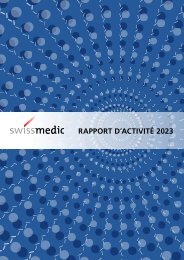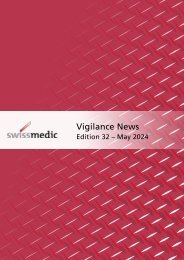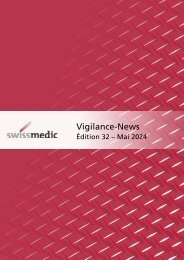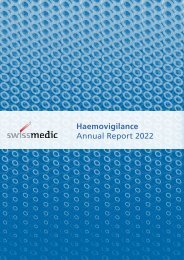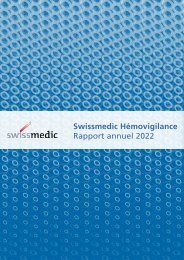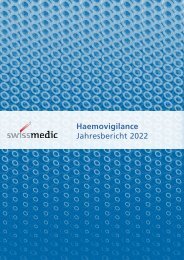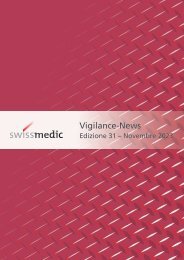Swissmedic Vigilance News Edition 21 – November 2018
In this edition: Isotretinoin and DOAC – Updates Confusion between amphotericin B formulations Guest articles: RPVC Zurich and RPVC Ticino Quality Assurance in Transfusion Practice Statistical Review 2017
In this edition:
Isotretinoin and DOAC – Updates
Confusion between amphotericin B formulations
Guest articles: RPVC Zurich and RPVC Ticino
Quality Assurance in Transfusion Practice
Statistical Review 2017
You also want an ePaper? Increase the reach of your titles
YUMPU automatically turns print PDFs into web optimized ePapers that Google loves.
Editorial<br />
Dear Reader<br />
There are various phases and methods in the<br />
life cycle of a medicinal product for recording<br />
potential risks.<br />
When applying for the authorisation of a new<br />
medicinal product, the prospective authorisation<br />
holder has to submit documentation on<br />
efficacy, quality and drug safety. The benefitrisk<br />
profile is established by means of pharmacological<br />
testing and, in particular, by<br />
clinical trials during the authorisation phase.<br />
However, since it is not possible to identify all<br />
risks, e.g. in certain patient groups and/or rare<br />
risks, during clinical trials, spontaneous reports<br />
on unexpected adverse reactions (ADR)<br />
after the authorisation of a medicinal product<br />
provide valuable evidence of a particular<br />
safety signal.<br />
The recording of individual ADR reports and<br />
observational studies after widespread or<br />
long-term use play an important role. Known<br />
existing risks and the resulting risk minimisation<br />
measures should be checked at regular<br />
intervals, particularly in order to determine<br />
whether new findings might require a modification<br />
of the risk-benefit profile. This condition<br />
applies equally to new active substances,<br />
such as the antidotes for the substance class<br />
of direct oral anticoagulants (DOAC), and to<br />
familiar medicinal products that have been<br />
around for a long time. In this edition of<br />
<strong>Swissmedic</strong> <strong>Vigilance</strong> <strong>News</strong> we report on updates<br />
to isotretinoin and psychiatric disorders,<br />
the risk of overdose arising from confusion<br />
between amphotericin B formulations and on<br />
the toxicity profile of morclofone.<br />
A periodic overview of the evaluation of any<br />
risks and signals is provided by the PSUR (Periodic<br />
Safety Update Report) for a medicinal<br />
product, which is prepared by the corresponding<br />
authorisation holder. An article on<br />
PSUR takes a closer look.<br />
Current changes in drug safety are also shown<br />
by the 2017 annual statistics for pharmacovigilance<br />
and vaccinovigilance.<br />
In vigilance in particular, it is extremely important<br />
to provide information to, and obtain<br />
feedback from, the affected patient groups<br />
and healthcare professionals. The “Guidelines<br />
for Quality Assurance in Transfusion Practice”<br />
were developed to protect patients from<br />
transfusion errors and resulting harm.<br />
Monitoring on site in hospitals, as in other institutions,<br />
is essential to ensure that therapeutic<br />
products remain safe. This fact is highlighted<br />
by the guest article on quetiapine in<br />
retirement homes in Ticino prepared by the<br />
Regional Pharmacovigilance Centre (RPVC) in<br />
Ticino.<br />
Another guest article, this time from the RPVC<br />
in Zurich, describes in detail the work of<br />
“RPVC collaboration”, illustrated by a case report.<br />
The exchange of information and communication<br />
between healthcare professionals<br />
and patients, the RPVC and the national Pharmacovigilance<br />
Centre at <strong>Swissmedic</strong> and the<br />
authorisation holders are key factors in assessing<br />
the potential risks associated with a<br />
medicinal product.<br />
The Editors<br />
Please send any suggestions or feedback on this issue of<br />
<strong>Swissmedic</strong> <strong>Vigilance</strong> <strong>News</strong> to:<br />
news.vigilance@swissmedic.ch.<br />
<strong>Swissmedic</strong> <strong>Vigilance</strong> <strong>News</strong> | <strong>Edition</strong> <strong>21</strong> <strong>–</strong> <strong>November</strong> <strong>2018</strong> 3 | 39




